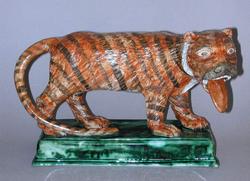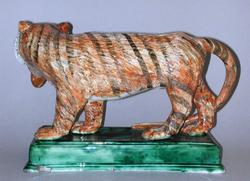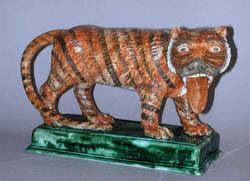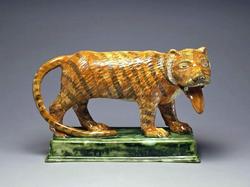Current Location: Gallery 27 (Glaisher)
Titles
Tiger
Maker(s)
Production:
Unidentified factory
(Probably)
Entities
Categories
Description
Large earthenware figure of a tiger, moulded with modelled additions, painted in green, orange, brown, and grey under lead-glaze
Earthenware, moulded with modelled additions, painted in green, orange, brown and grey under clear lead glaze. The tiger has an open mouth and long protruding tongue. The clay has been combed to suggest fur and the face is finely modeled, with a row of front teeth and sharp upper and lower incisors at either side of the tongue. The tiger is painted orange all over, with grey stripes and white whiskers. The base is a rectangular plinth with green pigment unevenly spread under or in the glaze. The underside is recessed and glazed, with four ventilation holes under the tiger’s legs.
Notes
History note: Mrs Arthur James; sold at Sotheby’s, 28 November 1910, Old Staffordshire Pottery the property of Mrs Arthur James, lot 52. Bought by Mr Stoner for £6 on behalf of Dr J.W.L. Glaisher, FRS, Trinity College, Cambridge
Legal notes
Dr J. W. L. Glaisher Bequest
Measurements and weight
Height: 22.5 cm
Acquisition and important dates
Method of acquisition: Bequeathed
(1928-12-07)
by
Glaisher, J. W. L., Dr
Dating
1820s
Circa
1820
-
Perhaps
1830
Note
Pearlware figures decorated with under-glaze colours were popular from the 1790s until the late 1830s. Although sometimes known as ‘Pratt ware’, they were made by many small potteries and are rarely marked. Classical and allegorical subjects were common, as were figures engaged in everyday work and leisure and wild, circus and domestic animals. Exotic animals such as lions and tigers would have been known from travelling menageries.
Under-glaze painted figures were moulded and biscuit fired, then painted or sponged with metal oxide colours before glazing and firing. This required only two firings, so they were cheaper to produce than enamelled figures, but they were restricted to a palette of earth colours (yellow, green, blue, purple, brown and black), since only metal oxide colours could withstand the high temperature of the glaze firing. Some, like this example, were very finely moulded and others used complex multi-part moulds. But by c.1835 three-part press-moulding had largely taken over, enabling even cheaper and faster production for a growing market.
People, subjects and objects depicted
Components of the work
Decoration
composed of
oxide colours
( green, orange, brown, and grey)
lead-glaze
Base
Depth 13.5 cm
Width 31 cm
Parts
Materials used in production
Earthenware
Techniques used in production
Moulding
: Earthenware, press-moulded and modelled, painted and lead-glazed.
Inscription or legends present
Inscription present: rectangular paper label
- Text: No.3319. Staffordshire figure of a tiger (with protruding tongue) on a green oblong base. b. at Sotheby' s Nov 28, 1910.
- Location: Underside of base
- Method of creation: Handwritten in black ink
- Type: Label
References and bibliographic entries
Identification numbers
Accession number: C.852-1928
Primary reference Number: 76231
Old object number: 3319
Stable URI
Audit data
Created: Saturday 6 August 2011
Updated: Monday 4 August 2025
Last processed: Monday 4 August 2025
Associated departments & institutions
Owner or interested party:
The Fitzwilliam Museum
Associated department:
Applied Arts








